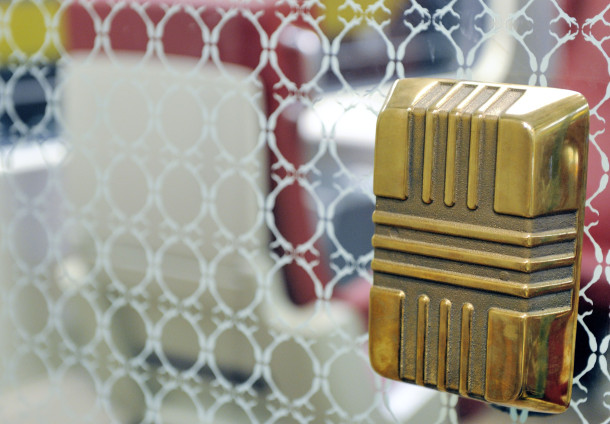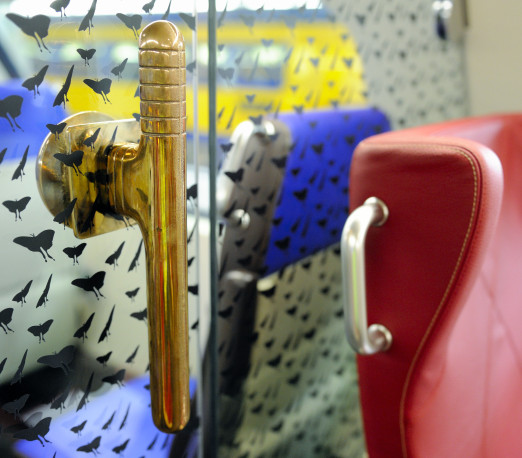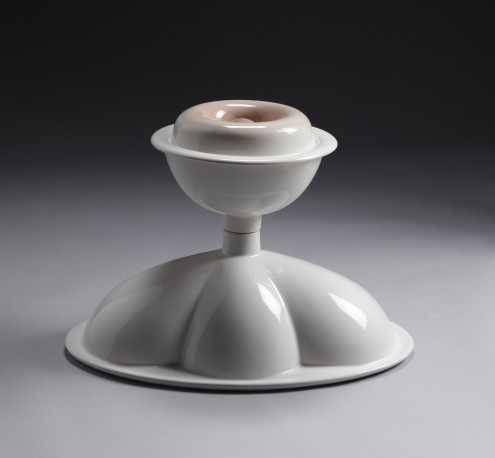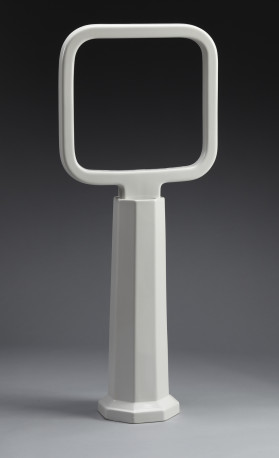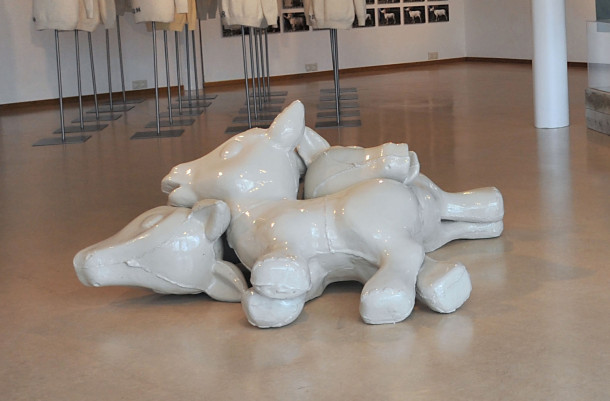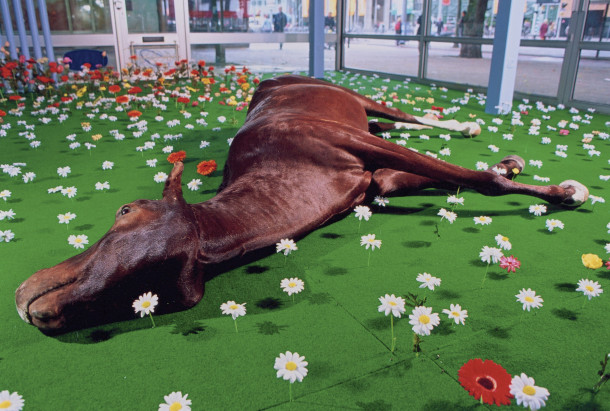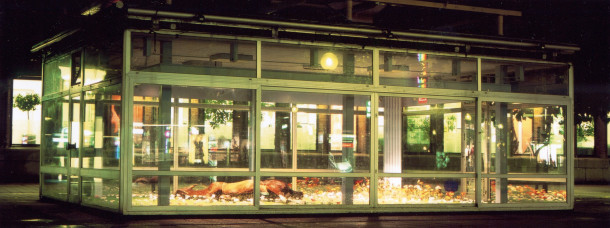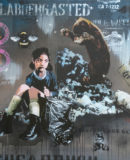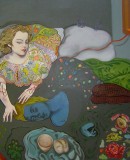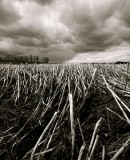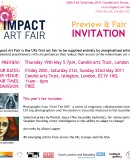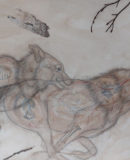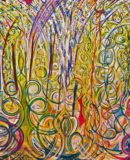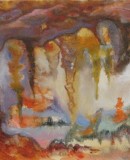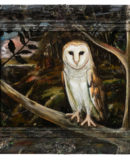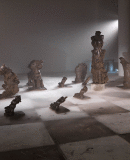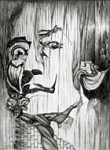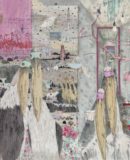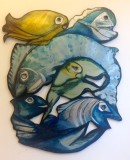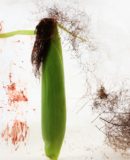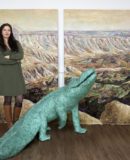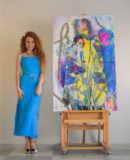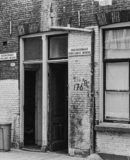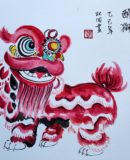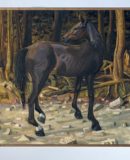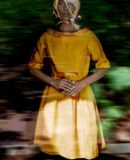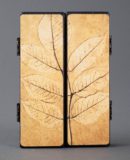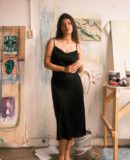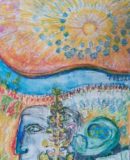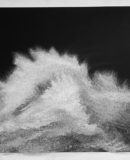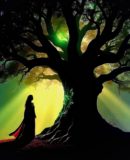World Artists and their Story, 7 - Onno Poiesz
World Artists and their Story, 6 – Onno Poiesz
I visit Onno Poiesz in his studio at the Keileweg, Rotterdam. Onno often works with ceramics, bronze and terrazzo. He designed the door handles, ‘door pushers’ in the new Dutch trains. Both of the older double-decker DDZ, as the latest double-decker, the VIRM.
Onoo Poiesz: ‘I got the project through a pitch. What is totally undesiable in a train? I tought. Chewing gum stains, grafitti, ashtrays, insignificant things. I called the proposal Undesirable Objects. Of those insignificant things I wanted to make doorknobs on the new glass doors. The first one I made was an ashtray. The ashtray, a demonic thing these days, came back in the train in a customer-friendly way, in bronze. One knob at one side of the door, and another, precisely fitting, on the other side of the door. With a pretty heavy weight, four kilos. I continued with fried fries containers, chewing gum that took the form of bubbles, also in bronze. In the VIRM double-decker there will be five variants. Poiesz: ‘I take my hat off to Dutch Railways that they have dared to do this project.’

Foot-and-mouth disease
Onno Poiesz’art products are varied. From large glazed planes, objects to sit on in a park, ceramic utensils, or so it looks at first glance, to a big brown horse in a room on Coolsingel, Rotterdam. Asked about a central denominator Poiesz says: ‘Impermanence, not in the sense of disappearing and rotting things, I rather look for existing forms with a temporary existence, for example plastic. I find the conversion of temporary products into sustainable ones, by petrifying them, a nice thought. That’s why I like working with ceramics, bronze and terrazzo. Although I am not a ceramist, I do like to refer to the ancient history of ceramics.’
He finds it interesting to make the work look like plastic. Casualties, tragic events, foot-and-mouth disease, packaged in a different jacket, are his themes. The ceramic work is usually in white. ‘From a business point of view bright colors would be better, but I prefer white or transparant glaze. The work is made with molds and with these tones this best visible. The Litttle Ponies – that was shown recently at the No Walls exhibition in the Fenix Loods – must have this tone.’
Sanitary ware factory in America
When he tackles something and he feels a tingle in his stomach, he is doing well. If the feeling isn’t there, it is better not to start. ‘Within a limited interest: art, I have a broad interest: art. Woodcutting seems delicious to me, but I won’t do it now, it must be a logical consequence of what I’m doing. Glass als seems very interesting to me, or a combination of glass and the materials I am working with now. And bronze, but I’m not sure yet.’
There is the stack collection and next to that the functionality collection. The Little Ponies is an example of the ‘stacks’. There are stacks of ponies, pigs, planes. ‘It has a great easinerss, because it has been thrown together. That feels good. There is a lot of technique involved. It is important for me that it looks easy.’
The functionality collection is quite different, tighter, it looks like utensils. In 2010 Onno was an Artist-in-Residence in the art space of the largest sanitary ware factory of America, the John Michael Kohler Arts Center in Sheboygan, Wisconsin. The work he did there had a similarity with the products the industrial factory created: utensils which at first glance could be used in the kitchen, urinals, monitors and chalices. Another name Onno uses for this series is the ‘confessional series’. One of the objects is called ‘Like a Prayer’ and looks indeed like a chalice.
This time in America has had quite an impact and has been a turning point for his work. The doorknobs for Dutch Railways are in line. Poiesz: ‘It is the pretty gray area between art and design. Many designers create art, but it starts to be interesting when artists make design.’
Horse at Coolsingel
He recently made a chandelier of aluminum for a school. It was shown at Witte de With Arts Center, Rotterdam. It was a ‘vanitas assignment’. It is all sampled. Poiesz: Assigments are an extension of your professional practise. But I look also at the environment. Can I find a theme, a story? As the artist of the IK werken (I works), Jan van Munster, said: ‘Making a nice scupture is easy, but a good work is something else.’ I aspire to this as well. It is very good that art itches, in this way it stays interesting.’
His Key Works are Little Ponies and Like a Prayer, he says. They exemplify the two main streams of his work, the ‘stacks’ and the ‘functionality collection’.
Onno Poiesz graduated in 1998 at St. Joost in Breda and post-graduated in 2000 at the Willem de konoing Academy in Rotterdam. He was searching for a while after that. Had several ‘very nice’ side jobs as a muralist, making the letter of the New Luxor Theatre and was collection management assitent at The Museum of Antiquities in Leiden. In 2001 he made a three-dimensional painting of a horse that was exhibited in an empty space at Coolsingel, Rotterdam.From that moment on he felt himself a real artist. Poiesz: ‘It was the story that worked. Is there a tragedy with the horse? The people continued to wonder. I realized: this is what I want to make, a sculpture with a story in a way that people are put on the wrong track.’
The art world
He experiences the art world as a dynamic world. ‘It is not just fun. But I would not want it different. Every day is exciting. I really feel the need to create new works.’ He has learned that it is important to reserve time for relationships and acquisitions. ‘At this point, I learn every day.’ He works in an environment with many artists, Buro Rotterdam and the Foundation Kunst & Complex. ‘A dynamic environment with artists keeps me moving. I’m pretty individual oriented, working with assistents is difficult for me. It crossed my mind to work from home, but it works best for me to be in an environment where more people work.’
http://ifthenisnow.nl/nl/verhalen/de-wereld-van-de-rotterdamse-kunstenaar-6-onno-poiesz
Disclaimer: The views, opinions and positions expressed within this guest article are those of the author Walter van Teeffelen alone and do not represent those of the Marbella Marbella website. The accuracy, completeness and validity of any statements made within this article are not guaranteed. We accept no liability for any errors, omissions or representations. The copyright of this content belongs to Walter van Teeffelen and any liability with regards to infringement of intellectual property rights remains with the author.

